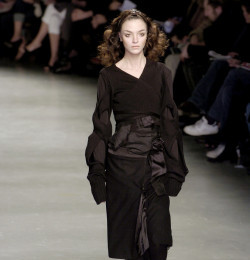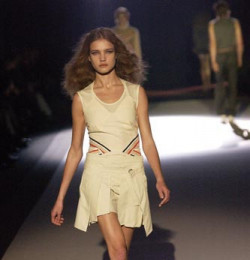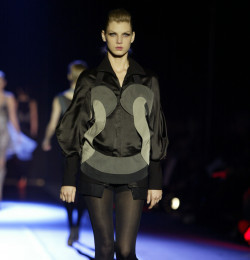

Martine Sitbon
New York, NY 10013
USA
About
founded by
Martine Sitbon
belongs to
Martine Sitbon
about
In 1985 Martine Sitbon launched her own label and showed her first Fashion show in Paris for Spring/Summer 1986.
In 1997 she showed her fist fashion show in Japan during Tokyo Fashion Week.
In 1989 she held her second fashion show in Osaka, Japan.
The Look
Although her early collections bore fairytale titles like Cinderella, it is rock music, especially of the 1970s, that has often been Sitbon's strongest inspiration. Her sculptural suiting, often based on masculine lines, underpins each season's looks but leathers, studs, and swirling sequins were present, emphasizing both her affinity with the music scene and her skilled use of luxury fabrics.
Sitbon's manipulation of delicate textiles, mixing soft pastel and metallic shades as artistically as fruitier colors. Her use of fine organzas, left to flow and ruffle in petal-like folds at the cuff and collars of blouses, was a recurring element in her work.
The freedom to use these sensuous fabrics comes from her strong Italian financial backing, enabling her to experiment with expensive 1970s decorative favorites like sequins and embroidery. In 1989 she punctuated cropped leather waistcoats with gold studs, manipulating Hell's Angel motifs to achieve more luxurious results. The idea was developed further in olive suede waistcoats with looped chains that hung down to the bright gold velvet skirts with which they were teamed, demonstrating the subtle use of color and shade pervading her work.
In the middle 1990s, Sitbon's rock preoccupations came into their own, in tune with retrospective trends that gave an edge to her signature use of flares and bell bottoms. She has shown them in everything from intricate pink and charcoal cut velvet to dazzling gold sequins.
Sitbon's work has always been carefully accessorized, with perspex-heeled platform sandals with black straps criss-crossing up the leg or with stringy leather or satin chokers. Her attention to detail inspires the trimmings she uses; a futuristic bent is also a recurring undercurrent with stretch fit leggings, tops and jackets in soft leather, stitched in circles and stripes, which emphasize the wearer's physique and give a starkly postmodern feel. A sculptural form continues in her suits, tailored to accentuate the shape of the body, like the soft Prince of Wales trouser suits in 1987 that exploited the cut of men's suits and, more severely, in fitted black jackets and miniskirts defined by white borders and flap pocket edges in 1990. Along with the simple raw silk trousers and supple blouses, they provided a classic foil to her more dandyish designs for Chloé and the more fantastic elements of her main line.
This ability to design strong daywear items as well as more luxurious garments has provided Sitbon with a wide customer base in Europe. She has skillfully manipulated fabrics and the mixing of very contemporary themes, masculine and feminine.
Martine Sitbon Fashion Shows


